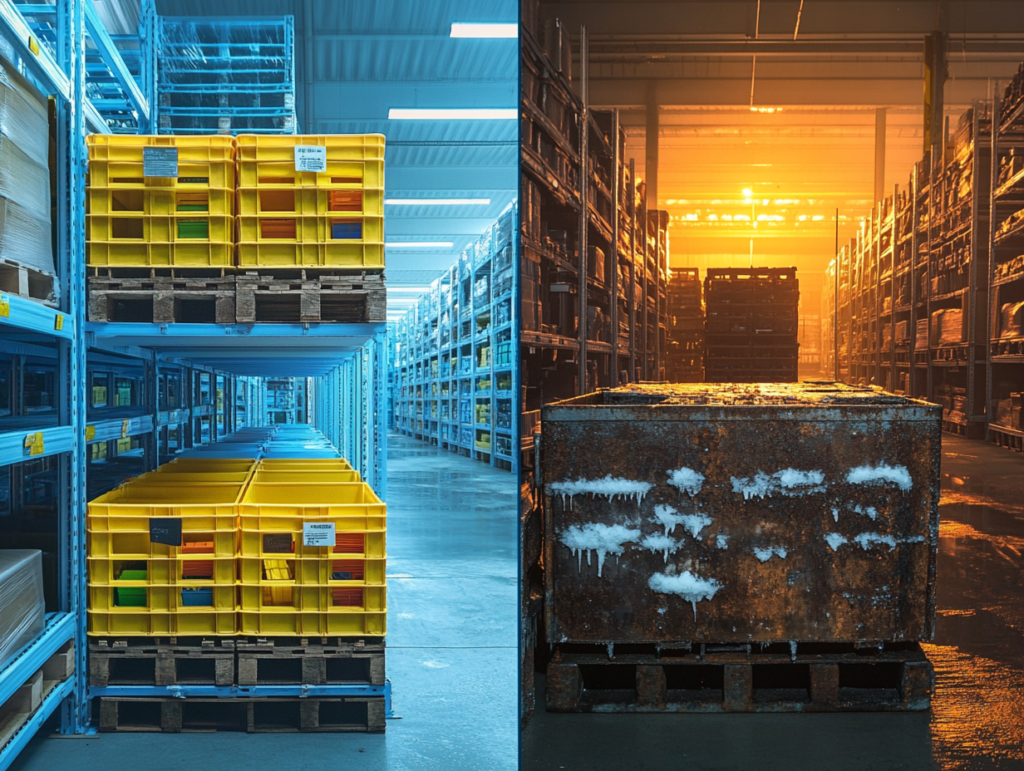In the high-stakes world of cold chain logistics, every detail matters—especially the choice of transport containers. While steel folding crates have long been seen as the “strongman” of industrial packaging, plastic alternatives are rapidly gaining ground. This article dives into a head-to-head comparison of these two materials, revealing why plastic folding crates outlast steel by 3x while cutting costs and boosting efficiency.
Round 1: Durability in Extreme Conditions
Plastic Crates:
- Corrosion Resistance: High-density polypropylene (HDPP) withstands -40°C to 80°C temperatures without rust or degradation, critical for cold chain environments with salty air or frequent washdowns.
- Impact Resilience: Plastic’s flexibility allows it to absorb shocks without permanent deformation. Tests show HDPP crates endure 1.5-ton dynamic loads—ideal for automated sorting systems.
Steel Crates:
- Vulnerability: Steel rusts in humid or saline environments (e.g., seafood transport), requiring costly coatings. Even coated steel cracks under repeated thermal cycling (freeze-thaw cycles).
- Dent Risk: Rigid steel bends permanently when dropped, creating gaps that compromise insulation integrity.
Verdict: Plastic crates last 10+ years vs. steel’s 3-5 years, slashing replacement costs by 60%.
Round 2: Weight & Transportation Efficiency
Plastic Crates:
- Lightweight Design: At 30% lighter than steel, plastic reduces fuel consumption by 15% per trip. A truck carrying plastic crates can haul 20% more payload.
- Fold-to-1/3 Size: Collapsible designs maximize empty return trip efficiency. For example, a Canadian cold chain operator saved 65% on container repositioning costs.
Steel Crates:
- Heavy Burden: Steel’s weight limits per-vehicle payloads. In China, 70% of trucks use open-top designs unsuitable for heavy steel containers, forcing costly specialized fleets.
- Fixed Shapes: Non-collapsible steel crates waste 40% trailer space when empty.
Verdict: Plastic cuts total logistics costs by 25% through fuel savings and space optimization.
Round 3: Cold Chain Compliance
Plastic Crates:
- Thermal Insulation: Multi-layer designs with vacuum-sealed walls maintain stable temperatures for 72+ hours, critical for pharmaceuticals and vaccines.
- Hygiene: Seamless surfaces prevent bacterial growth. RFID tags enable real-time temperature tracking—key for FDA/ISO audits.
Steel Crates:
- Thermal Bridging: Metal conducts cold, creating “hot spots” that risk product spoilage. A study showed steel containers vary ±3°C vs. plastic’s ±0.5°C.
- Cleaning Challenges: Welded seams trap contaminants, increasing sanitization time by 50%.
Verdict: Plastic reduces cold chain product loss from 30% to under 5%, meeting stringent EU/北美 standards.
Round 4: Total Cost of Ownership
| Factor | Plastic | Steel |
|---|---|---|
| Upfront Cost | $50-$80 per crate | $120-$150 per crate |
| Maintenance | Near-zero (no rust) | $20/year (coating repairs) |
| Replacement Cycle | 10+ years | 3-5 years |
| Recyclability | 100% recyclable HDPP | 70% scrap recovery rate |
Data sourced from U.S. and Canadian cold chain operators.
Hidden Savings:
- Insurance: Lower risk of temperature deviations cuts cargo insurance premiums by 15%.
- Labor: Plastic’s ergonomic handles reduce worker injuries by 40%.
The Future: Smart Plastic Crates Take Over
Innovations are widening the gap:
- AI-Optimized Designs: Machine learning tailors crate dimensions to cargo profiles, squeezing 15% more items per pallet.
- IoT Integration: Sensors monitor crate conditions (e.g., “door opened 3 times”) and auto-generate compliance reports.
- Circular Economy: Companies like Canada’s Thomson Group lease plastic crates, eliminating upfront costs and ensuring 95% reuse rates.
Conclusion
While steel crates still dominate niche heavy-industry applications, plastic folding crates are the clear winner for modern cold chains. With 3x longevity, 30% lighter weight, and AI-driven adaptability, they redefine value in logistics. As one German automaker put it: “Switching to plastic crates wasn’t just an upgrade—it was a supply chain revolution.”
Ready to Ditch Steel?
Download our free ROI calculator to see how much you’ll save or request a sample crate tested to your specific cold chain conditions.



